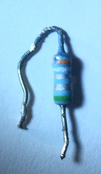F1 fuse repair: Difference between revisions
m (Note that the yageo equivalent of R1 is actually a mini sized resistor, so that anyone deciding to not go with the 1 W isn't surprised) |
m (grammar fix) |
||
| Line 5: | Line 5: | ||
<br> | <br> | ||
<br> | <br> | ||
The stock part, despite being labelled as a fuse, most closely resembles a 1/4 W, 0.39 Ω ± 10% metal film resistor. Various electronics component retailers sell part number MFR-25FTF52-0R39 by Yageo, which matches these specifications (it is actually a little bit better, and as of January 2020 it costs less than $9 USD for 100 of them). Note the green band on F1 actually represents a temperature coefficient, specifically indicating a value of 20 ppm/K--that is, for every 1K (1°C) increase in temperature, the resistance may change by no more than 20 parts per million.<ref>http://www.resistorguide.com/resistor-color-code/</ref> This information is typically provided in the datasheet of a resistor series, and the suggested Yageo part has a rating of 0ppm/°C up to 70°C (158°F), after which it becomes 100ppm/°C.<ref>https://www.mouser.com/datasheet/2/447/Yageo%20LR_MFR_2013-467719.pdf</ref> Bear in mind that a Dreamcast should never even get close to 70°C internally unless there is | The stock part, despite being labelled as a fuse, most closely resembles a 1/4 W, 0.39 Ω ± 10% metal film resistor. Various electronics component retailers sell part number MFR-25FTF52-0R39 by Yageo, which matches these specifications (it is actually a little bit better, and as of January 2020 it costs less than $9 USD for 100 of them). Note the green band on F1 actually represents a temperature coefficient, specifically indicating a value of 20 ppm/K--that is, for every 1K (1°C) increase in temperature, the resistance may change by no more than 20 parts per million.<ref>http://www.resistorguide.com/resistor-color-code/</ref> This information is typically provided in the datasheet of a resistor series, and the suggested Yageo part has a rating of 0ppm/°C up to 70°C (158°F), after which it becomes 100ppm/°C.<ref>https://www.mouser.com/datasheet/2/447/Yageo%20LR_MFR_2013-467719.pdf</ref> Bear in mind that a Dreamcast should never even get close to 70°C internally unless there is major overheating or an airflow restriction problem. | ||
<br> | <br> | ||
<br> | <br> | ||
R1, the other resistor on the Dreamcast controller board, is a standard 1/2 W, 13 Ω ± 5% resistor electrically matched by Yageo-branded part number MFR50SFTE52-13R (note: the Yageo part is actually a "mini" size resistor, so it is 1/2 W in the form factor normally used for 1/4 W). However, it appears that R1 is meant to be replaced with a 1 W, 13 Ω ± 5% resistor,<ref>http://www.thedreamcastjunkyard.co.uk/2017/02/the-official-sega-dreamcast-eu-service.html</ref> which is matched by Vishay-branded part number PR01000101309JR500. This resistor does not tend to fail as frequently as F1, however, and generally does not need to be replaced. It is part of the timekeeping circuit with the adjacent battery. | R1, the other resistor on the Dreamcast controller board, is a standard 1/2 W, 13 Ω ± 5% resistor electrically matched by Yageo-branded part number MFR50SFTE52-13R (note: the Yageo part is actually a "mini" size resistor, so it is 1/2 W in the form factor normally used for 1/4 W). However, it appears that R1 is meant to be replaced with a 1 W, 13 Ω ± 5% resistor,<ref>http://www.thedreamcastjunkyard.co.uk/2017/02/the-official-sega-dreamcast-eu-service.html</ref> which is matched by Vishay-branded part number PR01000101309JR500. This resistor does not tend to fail as frequently as F1, however, and generally does not need to be replaced. It is part of the timekeeping circuit with the adjacent battery. | ||
Revision as of 02:36, 11 February 2020
The Dreamcast's controller board contains a fuse labelled F1 that can blow and cause the console's controller ports to no longer function. This fuse can be replaced by an automatically resetting fuse that will revert back to a functioning state within a few moments.
The stock part, despite being labelled as a fuse, most closely resembles a 1/4 W, 0.39 Ω ± 10% metal film resistor. Various electronics component retailers sell part number MFR-25FTF52-0R39 by Yageo, which matches these specifications (it is actually a little bit better, and as of January 2020 it costs less than $9 USD for 100 of them). Note the green band on F1 actually represents a temperature coefficient, specifically indicating a value of 20 ppm/K--that is, for every 1K (1°C) increase in temperature, the resistance may change by no more than 20 parts per million.[1] This information is typically provided in the datasheet of a resistor series, and the suggested Yageo part has a rating of 0ppm/°C up to 70°C (158°F), after which it becomes 100ppm/°C.[2] Bear in mind that a Dreamcast should never even get close to 70°C internally unless there is major overheating or an airflow restriction problem.
R1, the other resistor on the Dreamcast controller board, is a standard 1/2 W, 13 Ω ± 5% resistor electrically matched by Yageo-branded part number MFR50SFTE52-13R (note: the Yageo part is actually a "mini" size resistor, so it is 1/2 W in the form factor normally used for 1/4 W). However, it appears that R1 is meant to be replaced with a 1 W, 13 Ω ± 5% resistor,[3] which is matched by Vishay-branded part number PR01000101309JR500. This resistor does not tend to fail as frequently as F1, however, and generally does not need to be replaced. It is part of the timekeeping circuit with the adjacent battery.

